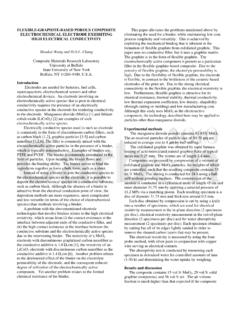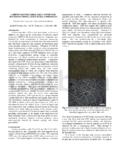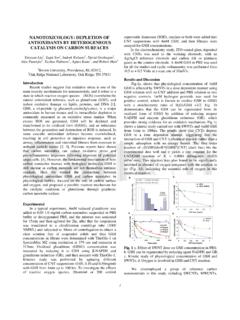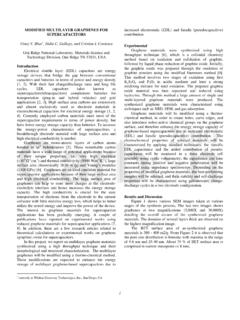Transcription of 2010: HYDROTHERMAL CARBON MATERIALS- …
1 13. HYDROTHERMAL CARBON MATERIALS C solid-state NMR also showed that starting from more economical , green AND valuable complex, real life biomass instead of clean sugars does not change the outcome of the HYDROTHERMAL carbonization Maria-Magdalena Titirici, Rezan-Demir-Cakan, Niki Baccile, Li reaction, and remarkable similarities between the products of Zhao, Shiori Kubo, Robin J White, Jelena Popovic, Markus Antonietti homologous series do occur, both with respect to morphology and local structural connectivity. Basically, the HYDROTHERMAL Max-Planck-Institute for Colloids and Interfaces, Wissenschaftspark carbonization reaction takes place in three important steps:1. Golm, D-14424 Potsdam Germany dehydration of the carbohydrate to (hydroxymethyl) furfural.
2 2. polymerization towards polyfuranes via Introduction further intermolecular dehydration. Sustainable Chemistry aspires to raise the value of less dangerous chemicals as well as it tries to produce high-quality The HYDROTHERMAL carbons obtained in the end from soluble, products environmentally friendly from preferable renewable non-structural carbohydrates are micrometer sized, spherically resources. It will be shown in this contribution that shaped particle dispersions, containing a sp2 hybridized HYDROTHERMAL carbonization can turn into a model case for backbone decorated with numerous polar oxygenated such a process: low value and widely available biomass can be functionalities still remaining from the original carbohydrate.
3 Converted into interesting CARBON nanostructures using The presence of these surface groups offers the possibility of environmentally friendly steps. These low cost nanostructured further functionalization and makes the materials more CARBON materials can then be designed for applications in hydrophilic and well dispersible in water. The size of the final crucial fields such as separation, energy conversion and particles depends mainly on the carbonization time and catalysis. Besides controlling the chemistry of carbonization precursor concentration inside the autoclave, as well as two other important prerequisites for the achievement of additives and stabilizers potentially to be added to the primary useful properties are the control over morphology both at reaction recipe.
4 Some SEM pictures obtained from various nano- and macroscale and the control over functionality by carbohydrate sources are given in Fig. 1. A typical yield for chemical means in HYDROTHERMAL carbonization. the CARBON material is about 50% of the initial amount of Obviously the technique of HYDROTHERMAL carbonization is carbohydrate not new [1], however it was only recently that this technique has been rediscovered by several working groups. [2,3,4] glucose HMF. Since then, it became an important technique for the production of various carbonaceous materials and hybrids, usually applied at mild temperatures (< 200 C) and in pure water inside closed recipients and under self generated pressure. Here, we would like to summarize the latest advances in xylose starch the synthesis of functional carbonaceous materials from different biomasses or biomass derived sources via the HTC.
5 Process. In the first part we will focus on general aspects of HYDROTHERMAL carbonization, using either carbohydrates or complex bio-mass to control structure formation in the presence of various catalysts and/or templates. In the second part, we will focus on some of the most promising applications Fig. 1 Scanning electron micrographs of various HYDROTHERMAL of the carbonaceous and hybrid materials obtained using carbons obtained from different carbohydrate sources (scale bar 2 m). HYDROTHERMAL carbonization. The carbonaceous materials collected directly after Results and Discussion HYDROTHERMAL carbonization possess only a small number of In order to gain some information about the fundamentals of micropores and therefore a small surface area (as compared to the HYDROTHERMAL carbonization process, the HYDROTHERMAL activated carbons).
6 For applications of these materials in fields carbonization of different carbohydrates and carbohydrate such catalysis, adsorption or energy storage, the presence of products was examined.[5,6] For instance, HYDROTHERMAL controlled porosity at the nanoscale is needed. This is why a carbons synthesized from diverse biomass (glucose, xylose, variety of techniques were applied to increase the surface area. maltose, sucrose, amylopectin, starch) and biomass derivatives For instance, if HYDROTHERMAL carbonization of carbohydrates (HMF and furfural) were treated under HYDROTHERMAL takes place in the presence of various templates or additives, conditions at 180 C and were analyzed with respect to their interesting pore systems can be imprinted.
7 [7,8,9,10] Figure 2. chemical and morphological structures by SEM, 13C solid- displays some morphologies of porous HYDROTHERMAL carbons state NMR and elemental analysis. obtained from carbohydrates. a) b) c). process extremely important for the production of nylon.[16]. HYDROTHERMAL carbonization found also applications in 50 nm 2 m 20 nm electrochemistry where it has been successfully used to coat Si d) e) f) nanoparticles with C as a promising electrode in Li ion batteries [17,12,13] or in indirect CARBON fuel cells.[18]. Other applications of HYDROTHERMAL CARBON imply water purification, removal of heavy metals from water as well 2 m as CO2 capture. The nitrogen doped CARBON materials have 200 nm 20 nm been successfully used as supercapacitors [19], adsorbents [20] or heterogenous catalysts in basic reactions, among which very important is the reaction of highly available CO2 with Fig.
8 2 a) SEM micrograph of a HYDROTHERMAL CARBON replica of SBA propylene oxide resulting in a cyclic carbonate (propylene 15 silica [8]; b) SEM of HYDROTHERMAL CARBON nanotubes obtained carbonate) which is a highly polar solvent, used as an using alumina membrane as template [9]; c) HR-TEM of hollow electrolyte component for lithium batteries as well as an HTC spheres obtaining from glucose in the presence of latex intermediate in polymer synthesis.[21]. nanoparticles d)TEM showing an ordered mesoporous HTC using the self assembly of pluronics in the presence of fructose e) HR-TEM of a carbogel obtained using the HYDROTHERMAL treatment of glucose in Conclusions the presence of albumin protein [15] f) SEM of HTC made via soft Although the HTC process has proved to be extremely templating between F127 pluronic and frucose successful in the production of many different distinctive structures rich in a variety of functional groups, there are still HYDROTHERMAL carbonization has been also intensively used for many aspects to be studied and considered in the future in the production of various hybrids.
9 Thus by performing this order to facilitate the design of novel carbonaceous structures, process in the presence of various metal salts [11] or with beneficial applications for our daily lives. preformed nanoparticles [12,13] nanocomposites with very interesting applications in extremely important areas can be References [1] Berl, E, Schmidt, A., 1932, 493, 97. produced. [2] Titirici M. M., Antonietti M. Chem. Soc. Rev., 2010, 39, 103. [3] Hu B., Wang K., Wu L., Yu , Antonietti M, Titirici Adv. Mater. Another gemstone in the portfolio of rational CARBON synthesis 2010, 22, 1 16. is nitrogen-doped carbons. It was therefore straightforward to [4] Hu B., Yu , Wang K., Liu L., Xu X. W., Dalton Trans., 2008, 5414. [5] Titirici , Antonietti M.
10 , Baccile N., green Chem., 2008, 10, 1204. apply HTC by including sustainable nitrogen sources with [6] Baccile N., Laurent G, Babonneau F, Fayon F, Titirici Antonietti appropriate co-reactivity to produce such materials. Thus we M., J. Pys. Chem. C, 2009, 113, 9644. can either use naturally amino containing carbohydrates such [7] Titirici , Thomas A., Antonietti M, Adv. , 2007,17,1010. as glucoseamine or chitosane or a mixture of carbohydrates [8] Titirici , Thomas A. Antonietti M., J. , 2007,17,3412. [9] Kubo S, Demir-Cakan R, Zhao L, White R. J., Titirici , Chem. and natural containing N compounds such as aminoacids or , 3, 188. proteins to hydrothermally produce such desired materials [10] Qian , Yu , Luo , Gong J. Y., Fei , Liu Chem.









